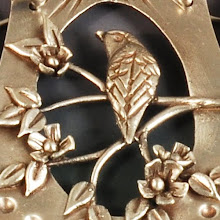In preparation for some explorations with enamels, I torch fired a set of opaque enamel color samples today. I've played with the transparents before, in my kiln, but never the opaques and rarely torch firing, since the kiln is right there and easy. I feel so positively scientific today, cutting properly even-sized copper rectangles and working systematically through the colors. I learned a bit about how fast to heat, how to judge when the enamels were fully fused, and how much work cleaning copper is.
I experimented with Penny Brite cleaner, a fiberglass brush, and citric acid pickle. All I can say is all of it requires elbow grease. Fine silver seems so easy after this!
Even so, I now have an idea of what color to expect, which is distinctly different than the appearance of the powdered enamel. 
Thompson Enamel Colors, one layer directly on copper(l to r), top: 1880 Flame Red, 1850 Pumpkin, 1810 Buttercup, 1237 Butter, 1030 Foundation White
bottom: 1685 Cobalt, 1560 Bluejay, 1525 Aqua, 1420 Mint, 1360 Jungle
I even played a bit with a second layer of enamel, scratching off part of that layer in the technique called sgraffito. I like the possibilities of this, but need to refine my method, perhaps getting some finer mesh powder to avoid that grainy look. I did find some nice sgaffito video tutorials on the Art Jewely Magazine website (member login required), after I tried blindly, of course. I'm off to read again in my collection of enameling books, especially my favorite by Linda Darty, The Art of Enameling: Techniques, Projects, Inspiration.
Now I'm feeling the urge to make a set of transparent color samples, and maybe to do the same process for silver. Wow, it's like a laboratory out in my glass studio!
I've also been doing my research, searching the internet for photos of work by my favorite enamel artists, compiling it into digital files along with my notes about why I like it, how they did it, where I could go with those ideas.
Yep, it's a veritable science project around here!
skip to main |
skip to sidebar

Contact Form
Newsletter Signup

- Vickie Hallmark
- Artist, scientist, and gardener...I fabricate contemporary jewelry inspired by the flora and fauna outside my studio windows.
Favorite Blogs -- Metal
-
-
-
-
-
Compatibility of Hadar’s Metal Clays6 years ago
-
-
-
-
-
-
-
-
Not really bloggin' but I am Instagrammin'10 years ago
-
-
-
The Big Move11 years ago
-
-
Favorite Blogs -- Glass
Favorite Blogs -- Fiber
Favorite Blogs -- Inspiration
Search This Blog
Categories
- Argentium + metal clay (15)
- beads (141)
- bells (1)
- bird (12)
- Bird a Week (20)
- bird hournal (1)
- bird journal (45)
- birdhouse (9)
- birds (101)
- blog carnival (5)
- blog/website (11)
- books (3)
- bracelet (4)
- bronze clay (34)
- brooch (2)
- brooches (4)
- cactus (6)
- class (10)
- components (3)
- conference (4)
- copper clay (2)
- custom jewelry (1)
- designing jewelry (15)
- drawings (38)
- earrings (35)
- electroforming (49)
- enamel (46)
- exhibitions (18)
- fauna (10)
- faux bone (4)
- fiber (1)
- flora (8)
- four a month (3)
- galleries (6)
- garden (4)
- glass (78)
- gold (1)
- inspiration (54)
- jewelry (17)
- jewelry school (12)
- journal (7)
- kiln (1)
- kitchen (15)
- labels (1)
- leaf collection (1)
- leaves (1)
- marketing (2)
- Master Muses (15)
- metal clay (83)
- motivation (2)
- painting (2)
- paintings (24)
- patina (1)
- photographs (16)
- planets (3)
- pods (8)
- publications (36)
- quilts (22)
- resin (4)
- Ring a Week (11)
- rings (11)
- routine (1)
- shop (1)
- show reviews (3)
- silver clay (56)
- sketches (1)
- sterling clay (23)
- stock tank pond (1)
- stones (2)
- studio (14)
- tibial plateau fracture (10)
- tools (1)
- trade shows (1)
- travel (18)
- treeto (1)
- treetop (4)
- trends (1)
- tricks & tips (1)
- tutorial (1)
- vessels (15)
- wholesale (2)
- workshop (26)





















